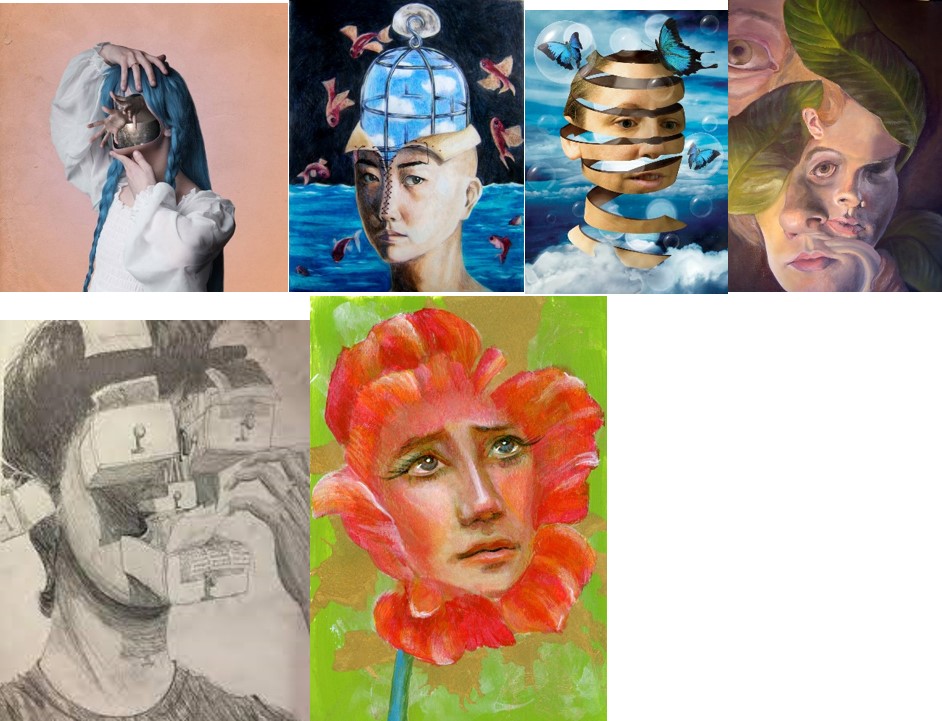Dali and Surrealism
Florida Standards
- 912.H.1.5 Investigate the use of technology and media design to reflect creative trends in visual culture.
- 912.F.2.1 Examine career opportunities in the visual arts to determine requisite skills, qualifications, supply-and-demand, market location, and potential earnings.
Goals
- Plan and execute a composition that shows strong compositional arrangement.
- Use the Elements of Art to showcase emphasis by creating a focal point in the piece.
- Understand the Rule of Thirds and object placement to create visual interest in artworks.
Targets
- Create a composition from magazine clippings that reflects a “dream-like” event
- Redraw the image to canvas using a grid technique to ensure proper proportion and scale of the images.
- Utilize value with acrylic paint using tint, tone and shade to create depth and realistic qualities to the imagery in the composition.
Concepts/Content
- Watch short clip on Disney + if available called Destino
- Discuss The Dali Museum in St. Petersburg, Fl
- Annual competition through museum for students
Vocabulary
- Emphasis
- Rule of Thirds
- Composition
- Compositional Arrangement
- Focal Point
- Visual Interest
- Juxtaposition
- Translation
- Transformation
Formative
Peer Critiques, One-on-One Conferences, Sketchbook or Process Journals, Gallery Walks
Summative
Final Art Projects, Written Art Critiques, Artist Statement, Art Appreciation Assessments, Art Showcase or Exhibition, Final Written Reflections
ESE/ESOL
- Use non-linguistic cues, check for understanding and reinforce effort through practice. Make alterations based on lesson and individual student needs.
- Make alterations based on lesson and individual student needs.
- Allowing frequent breaks and allowing content modifications when necessary and for individual student needs.
Scaffold
- Introduction to Surrealism:
- Start by discussing the surrealist art movement and its focus on the irrational, dreamlike, and symbolic elements in art. Share examples of famous surrealist artworks and artists.
- Surreal Self-Portrait Concept:
- Explain that students will be creating self-portraits but with a surreal twist. They should aim to express their inner thoughts, dreams, fears, or emotions through symbolic and surreal elements.
- Sketching the Self-Portrait:
- Instruct students to make an initial sketch of their self-portrait. They should begin with a traditional self-portrait and then plan how they will incorporate surreal and symbolic elements into the composition.
- Surreal Elements:
- Encourage students to brainstorm surreal elements and symbolism that represent their inner world. These could include dreamlike landscapes, metamorphoses, distorted proportions, and unexpected combinations of objects.
- Adding Details:
- Once the surreal elements are planned, students can proceed to add intricate details to their self-portraits. Emphasize the importance of precision and fine lines to create a visually compelling image.
- Color and Media (Optional):
- If students wish to use color, they can apply colored pencils, markers, or paints to their self-portraits. Color can add depth and evoke different emotions.
- Collage (Optional):
- For an added layer of surrealism, students can incorporate collage elements. They can cut out images from magazines, old photographs, or printed materials and integrate them into the self-portrait to create juxtapositions and unusual connections.
- Presentation and Discussion:
- Have each student present their surreal self-portrait to the class. They should explain the symbolic elements, surreal components, and the emotions or thoughts they aimed to convey.
- Reflection and Critique:
- Conclude the project with a reflection session where students can discuss what they've learned about surrealism, self-expression, and artistic symbolism. Encourage peer critique and feedback.

